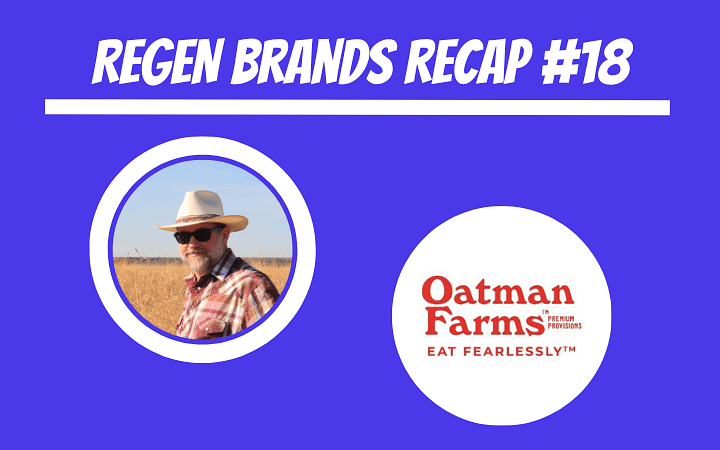
Dax Hansen @ Oatman Farms:
A Southwestern, Regenerative Wheat Revolution
Oatman Farms is supporting regenerative agriculture through its portfolio of regenerative organic baking mixes that are made with heritage and drought-resistant wheat varieties grown at Oatman Flats Ranch in Southwest Arizona. The farm has been in the Hansen family since the 1950s.
“We have to eat what we grow and have to grow something that helps the earth.” – Dax
The Brand
Oatman Farms sells its 6 SKUs of bread and pancake/waffle mixes directly to consumers on the company’s website, on Amazon, and in a number of retail outlets in Arizona including Fry’s and Whole Foods. They also have a robust food service business, selling to some of the leading chefs and restaurants in the region.
The foundation of many of their products is White Sonora Wheat, an heirloom grain introduced 300 years ago by the Spaniards and quickly adopted by the Maricopa and Pima Native Americans in Southern Arizona and Mexico as it thrives in the salty soil and harsh temperatures. They also grow Red 5, Blue Beard Durham, and a modern heirloom varietal created by the Washington State Bread Lab meant for whole grain uses.
So WHAT we grow is just as important as HOW we grow it??

As with many regenerative brands, selling directly to consumers is Oatman Farm’s most profitable sales channel given cost pressures from commodity markets (particularly for grains) and retail margins. As Dax explained it, organic wheat as a commodity is priced between $0.25-0.35/pound; the costs to regeneratively grow and mill his wheat and produce his products adds up to about $0.75-$1.25/pound. By creating high-value items with their wheat and barley, they can sustain their regenerative practices and still create a high-quality, nutrient-dense product.
Their “Why”
After decades of struggling with dwindling water and drought, the Hansen family was ready to sell their ranch. Motivated by a desire to preserve his family’s legacy and steward the land, Dax took on the ranch in January 2019 as a side hustle to his job as a lawyer/partner at Perkins Coie LLP where he had been practicing for two decades. The ranch was a liability, to say the least, with broken ditches, sterile soil, and sunken wells. Dax quickly realized that growing food and creating a CPG brand was the best way to preserve the legacy of his family’s ranch.
Relying on hydrologists, ethnobotanists, and experts like Kevin Morse, the founder of Cairnspring Mills, and the Regenerative Organic Alliance, Dax built a toolkit to nurse his land back to health. They committed to introducing White Sonora Wheat and cultivating it using regenerative organic practices that integrated a conservation mindset and place-based indigenous wisdom.
By March 2019, Dax had planted conservation cover crops, pioneering regenerative practices to restore the topsoil. And because the farm had laid fallow for so many years, without chemical inputs, they were able to get organic certification right away.
Within a year, life returned to their soil. They stay away from chemical fertilizers and have introduced managed grazing, focusing less on yield and more on the health of the soil and nutrient density of their grain. Hansen credits his farm manager, Yadi Wang (an environmental science PHD), for much of their success in rebuilding the fertility of the farm.
“When you let Mother Nature do her thing, she surprises you and works pretty fast.” – Dax
<svg width="50px" height="50px" viewbox="0 0 60 60" version="1.1" xmlns="https://www.w3.org/2000/svg" xmlns:xlink="https://www.w3.org/1999/xlink"><g stroke="none" stroke-width="1" fill="none" fill-rule="evenodd"><g transform="translate(-511.000000, -20.000000)" fill="#000000"><g><path d="M556.869,30.41 C554.814,30.41 553.148,32.076 553.148,34.131 C553.148,36.186 554.814,37.852 556.869,37.852 C558.924,37.852 560.59,36.186 560.59,34.131 C560.59,32.076 558.924,30.41 556.869,30.41 M541,60.657 C535.114,60.657 530.342,55.887 530.342,50 C530.342,44.114 535.114,39.342 541,39.342 C546.887,39.342 551.658,44.114 551.658,50 C551.658,55.887 546.887,60.657 541,60.657 M541,33.886 C532.1,33.886 524.886,41.1 524.886,50 C524.886,58.899 532.1,66.113 541,66.113 C549.9,66.113 557.115,58.899 557.115,50 C557.115,41.1 549.9,33.886 541,33.886 M565.378,62.101 C565.244,65.022 564.756,66.606 564.346,67.663 C563.803,69.06 563.154,70.057 562.106,71.106 C561.058,72.155 560.06,72.803 558.662,73.347 C557.607,73.757 556.021,74.244 553.102,74.378 C549.944,74.521 548.997,74.552 541,74.552 C533.003,74.552 532.056,74.521 528.898,74.378 C525.979,74.244 524.393,73.757 523.338,73.347 C521.94,72.803 520.942,72.155 519.894,71.106 C518.846,70.057 518.197,69.06 517.654,67.663 C517.244,66.606 516.755,65.022 516.623,62.101 C516.479,58.943 516.448,57.996 516.448,50 C516.448,42.003 516.479,41.056 516.623,37.899 C516.755,34.978 517.244,33.391 517.654,32.338 C518.197,30.938 518.846,29.942 519.894,28.894 C520.942,27.846 521.94,27.196 523.338,26.654 C524.393,26.244 525.979,25.756 528.898,25.623 C532.057,25.479 533.004,25.448 541,25.448 C548.997,25.448 549.943,25.479 553.102,25.623 C556.021,25.756 557.607,26.244 558.662,26.654 C560.06,27.196 561.058,27.846 562.106,28.894 C563.154,29.942 563.803,30.938 564.346,32.338 C564.756,33.391 565.244,34.978 565.378,37.899 C565.522,41.056 565.552,42.003 565.552,50 C565.552,57.996 565.522,58.943 565.378,62.101 M570.82,37.631 C570.674,34.438 570.167,32.258 569.425,30.349 C568.659,28.377 567.633,26.702 565.965,25.035 C564.297,23.368 562.623,22.342 560.652,21.575 C558.743,20.834 556.562,20.326 553.369,20.18 C550.169,20.033 549.148,20 541,20 C532.853,20 531.831,20.033 528.631,20.18 C525.438,20.326 523.257,20.834 521.349,21.575 C519.376,22.342 517.703,23.368 516.035,25.035 C514.368,26.702 513.342,28.377 512.574,30.349 C511.834,32.258 511.326,34.438 511.181,37.631 C511.035,40.831 511,41.851 511,50 C511,58.147 511.035,59.17 511.181,62.369 C511.326,65.562 511.834,67.743 512.574,69.651 C513.342,71.625 514.368,73.296 516.035,74.965 C517.703,76.634 519.376,77.658 521.349,78.425 C523.257,79.167 525.438,79.673 528.631,79.82 C531.831,79.965 532.853,80.001 541,80.001 C549.148,80.001 550.169,79.965 553.369,79.82 C556.562,79.673 558.743,79.167 560.652,78.425 C562.623,77.658 564.297,76.634 565.965,74.965 C567.633,73.296 568.659,71.625 569.425,69.651 C570.167,67.743 570.674,65.562 570.82,62.369 C570.966,59.17 571,58.147 571,50 C571,41.851 570.966,40.831 570.82,37.631"></path></g></g></g></svg>View this post on Instagram
Water and the West
Dax believes regenerative agriculture could be a solution to the water crisis in the West, but sadly it’s been absent from the conversation. Compared to alfalfa and cotton which require about 8 acre-feet of water, White Sonora Wheat requires only about 3 acre-feet. And that number can decrease even further under regenerative management which is building water infiltration levels and carrying capacity in the soil.
“There’s no getting around the fact that in the West, we use a lot of water. With 70-85% of the Colorado River going to agriculture, it’s easy to demonize farmers. If we can find a way to keep farmers on the land they know and love, grow different crops and create markets for what they can grow with less water, everybody wins.” – Dax
Our Path to 50% Market Share 4 ReGen
For Dax, it all comes down to building community. Unlike the current commercial model where the crops we grow are processed and eaten in states and even continents away, Dax believes we need regenerative communities by state and region to work collectively and build markets in their own backyards. He gives the example of the local ranchers he works with to graze his fields and how together they can both profit off the land – Dax, by receiving natural fertilizer to enrich the grains used in his mixes, the rancher by accessing regenerative organic feed for their sheep.
“We have to retool the current food system and prioritize things like rebuilding human health and the environment. As pioneers, we’re not making nearly as much money as we need to. But as soon as we get a bit of traction, start getting consumers, award-winning chefs and breweries demanding our product, we can make this model work.” – Dax
You can check out the full episode with Dax from Oatman Farms HERE.
Subscribe to future episodes of the ReGen Brands Podcast on your favorite podcast platform using the buttons below. You can help support our mission of growing regenerative CPG brands with a 5-star rating!
Stay engaged in the conversation by subscribing to our weekly newsletter, The ReGen Brands Weekly, and connecting with us on LinkedIn (Kyle & AC).
Your support of the show and these brands truly means the world to us. Thank you!
This ReGen Recap was produced with support from Kristina Tober

